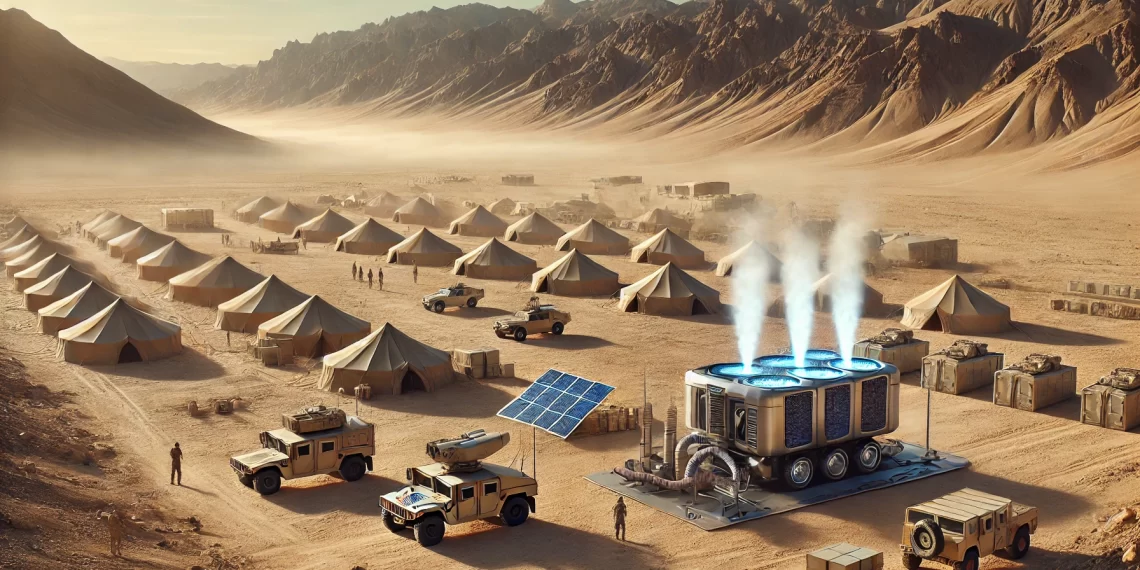A scientific breakthrough at Northwestern University has revealed a new way to generate water at the molecular level, offering solutions not just for space exploration, but also for future military operations in water-scarce environments. Researchers witnessed hydrogen and oxygen atoms merging to create nanoscale water bubbles for the first time, a process catalyzed by palladium. This discovery could profoundly impact how militaries address the logistical challenge of supplying water in the field, particularly in arid regions where fresh water is scarce.
Water supply is one of the most critical and cumbersome logistical tasks faced by military operations. Along with energy generation, ensuring a steady and reliable source of water for troops entails transporting large quantities of the resource to often remote and inhospitable areas. In arid regions or places where fresh water is inaccessible, this challenge becomes even more pronounced. The ability to generate water on-site, using only basic gases and recyclable materials, could transform how modern armies operate.
Traditionally, water generation and purification methods require substantial energy and infrastructure. Desalination plants, water purification units, and logistical supply chains have long been necessary to meet the needs of large military forces. In the heat of battle or in prolonged deployments, the transportation and security of these water supplies add layers of complexity to mission planning. This new discovery, enabled by cutting-edge analytical technology developed last year, could change all that by allowing military forces to chemically generate water on-demand without the need for extreme conditions or bulky equipment.
The palladium-catalyzed process discovered by the Northwestern team does not rely on fire or other high-energy methods but instead combines hydrogen and oxygen gases at ambient conditions to create water. Professor Vinayak Dravid, who led the research, likened the process to the scene in The Martian where the protagonist uses rocket fuel to generate water, except this method bypasses the need for fire or extreme heat. The only materials required are palladium, hydrogen, and oxygen—readily available and abundant resources. In a military context, this would mean that soldiers could potentially carry small quantities of palladium with them and use surrounding atmospheric gases to generate fresh water in the field.
The impact on future warfare could be immense. In environments like the deserts of the Middle East or arid regions in Africa, access to clean water is often one of the most significant constraints for military forces. This new water generation method could enable troops to reduce their dependence on long, vulnerable supply chains for water, increasing their operational flexibility and reducing logistical risks. For special operations units or forward-deployed troops operating deep behind enemy lines, the ability to produce water on-demand could mean the difference between success and failure during extended missions.
Additionally, the technology holds promise for use in forward operating bases (FOBs) or other semi-permanent military installations where the local environment does not provide sufficient water. With only a hydrogen source—something as simple as portable hydrogen tanks—military engineers could deploy the palladium-based system to generate water continuously. This could reduce the need for expensive and logistically complex resupply missions in dangerous combat zones, improving the overall efficiency of military operations.
Dravid’s team emphasized that the palladium used in the process is fully recyclable. After the hydrogen and oxygen reaction creates water, the palladium is not consumed but returns to its original state, ready for reuse. This makes the process highly sustainable and practical for military applications, where long-term resource management is crucial. The scalability of the process—from generating nanoscale water bubbles in a lab to producing significant quantities of water in the field—further highlights its potential for future applications.
Beyond the immediate military benefits, the discovery opens doors for broader use in disaster relief, refugee camps, and other humanitarian operations where water scarcity poses life-threatening risks. However, for military planners focused on the future of warfare, this breakthrough represents an opportunity to rethink how logistics are handled in environments where water and other resources are scarce. With further development, the technology could become a standard tool for sustaining military forces in harsh, remote locations where current methods of water supply are impractical or impossible.
This research exemplifies how advances in science and technology can directly influence military capabilities, particularly in resource management. By unraveling the mechanics of nanoscale water generation, the Northwestern team has provided a glimpse of what future warfare could look like, where logistical constraints are minimized, and operational efficiency is maximized. The ability to generate water in real-time could fundamentally change how armies approach both short-term missions and long-term deployments in hostile environments.








